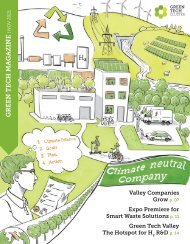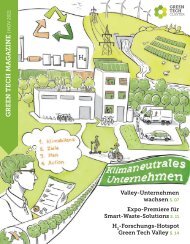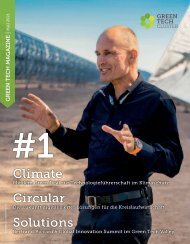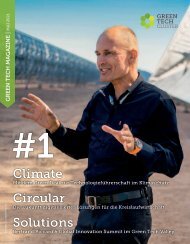Green Tech Magazine December 2017 en
You also want an ePaper? Increase the reach of your titles
YUMPU automatically turns print PDFs into web optimized ePapers that Google loves.
GREEN TECH MAGAZINE 5<br />
INNOVATIVE. The<br />
Sci<strong>en</strong>ce Tower has<br />
be<strong>en</strong> designed as a<br />
‘Living Lab’. It links<br />
research, developm<strong>en</strong>t<br />
and industry.<br />
Credits: Harry Schiffer<br />
houses the <strong>Gre<strong>en</strong></strong> <strong>Tech</strong> Cluster and other<br />
companies dealing in topics pertaining to a<br />
gre<strong>en</strong> future.<br />
100 % r<strong>en</strong>ewable <strong>en</strong>ergy<br />
From a technological view the Sci<strong>en</strong>ce Tower<br />
is a project used to demonstrate urban technology<br />
aimed at ‘zero emissions’, says Smart<br />
City Graz Project Manager Kai-Uwe Hoffer.<br />
The project’s objective is to supply the city of<br />
Graz with power from the region produced<br />
from r<strong>en</strong>ewable sources by 2050. The Sci<strong>en</strong>ce<br />
Tower is part of a local power and <strong>en</strong>ergy<br />
network which also includes the large<br />
solar power system running at the premises<br />
of SFL technologies in Stallhof<strong>en</strong> (SFL <strong>en</strong>ergrid).<br />
Using the heat storage system b<strong>en</strong>eath<br />
the building and heat pumps, the tower’s <strong>en</strong>tire<br />
<strong>en</strong>ergy demand can be covered with solar<br />
power, says Mario Müller from SFL technologies.<br />
First large-scale use of Grätzel cells<br />
Power is mostly g<strong>en</strong>erated through the <strong>en</strong>ergy<br />
glass which converts (sun) light into electrical<br />
<strong>en</strong>ergy. Contrary to traditional photovoltaic<br />
cells, the <strong>en</strong>ergy glass of this Grätzel cell<br />
is dye-s<strong>en</strong>sitised. Its creator, Swiss researcher<br />
Michael Grätzel, inv<strong>en</strong>ted the principle in the<br />
early 1990s. Similar to photosynthesis, his cells<br />
convert sunlight into <strong>en</strong>ergy using a dye. The<br />
glass consists of two coated adjac<strong>en</strong>t panes<br />
of glass with the gap in betwe<strong>en</strong> filled with a<br />
coloured electrolyte. Thus, it can receive light<br />
“Without a doubt, the Sci<strong>en</strong>ce Tower<br />
will become a magnet –<br />
and not just for Europe but<br />
for the <strong>en</strong>tire world.“<br />
Prof. Michael Grätzel,<br />
Swiss researcher and winner of the<br />
Global Energy Prize <strong>2017</strong><br />
from both sides. Never before have Grätzel<br />
cells be<strong>en</strong> used at such a large scale as on the<br />
Sci<strong>en</strong>ce Tower. The raw material is produced<br />
in Switzerland, refined in St. Marein in Styria,<br />
while the compon<strong>en</strong>ts are prepared for installation<br />
at Stallhof<strong>en</strong>. Researchers are already<br />
working on the next g<strong>en</strong>eration of Grätzel<br />
cells. These are expected to achieve a degree<br />
of effici<strong>en</strong>cy of more than 20 %.<br />
The new sun-powered clock tower<br />
In the summer, the heat produced by the façade<br />
technology is routed into the ground<br />
via the geothermal system using twelve geothermal<br />
probes with a depth of 200 metres<br />
and a l<strong>en</strong>gth of 2.4 kilometres each. Come<br />
winter, the heat is retrieved from the ground<br />
and increased to heating temperature by the<br />
heat pumps. Another special feature of the<br />
Sci<strong>en</strong>ce Tower is the use of special thin glass<br />
in a large format suitable for buildings and its<br />
moving sun protection system in the façade<br />
which orbits the tower once every 24 hours.<br />
It supplies optimal power yield, provides<br />
shade for the office space and – just like a<br />
sun dial – shows the time, too. “That probably<br />
makes the Sci<strong>en</strong>ce Tower the clock tower<br />
of the right hand bank of the Mur River and<br />
of the digital age,” Mario Müller states with<br />
a smirk.<br />
Building managem<strong>en</strong>t 4.0<br />
Talking about digital: Thanks to building information<br />
modelling (BIM) – a sort of 4.0 in<br />
building managem<strong>en</strong>t – the tower’s building<br />
technology is controlled digitally. Using this<br />
technology, a twin of the Sci<strong>en</strong>ce Tower is<br />
created that can be used to simulate many<br />
things: Incid<strong>en</strong>ce of light, assembly processes,<br />
facility managem<strong>en</strong>t and of course costs.<br />
BIM is an <strong>en</strong>ormous help, because changes<br />
in such a large building usually have other effects<br />
and the error redundancy is great. It<br />
is therefore important to work digitally on<br />
the correction of error chains. For ultimately,<br />
several buildings at Smart City are to act as<br />
g<strong>en</strong>erators in the future, mini power plants<br />
that will form a large power plant wh<strong>en</strong> combined.<br />
www.smartcitygraz.at<br />
info.sci<strong>en</strong>ce-tower.at


















